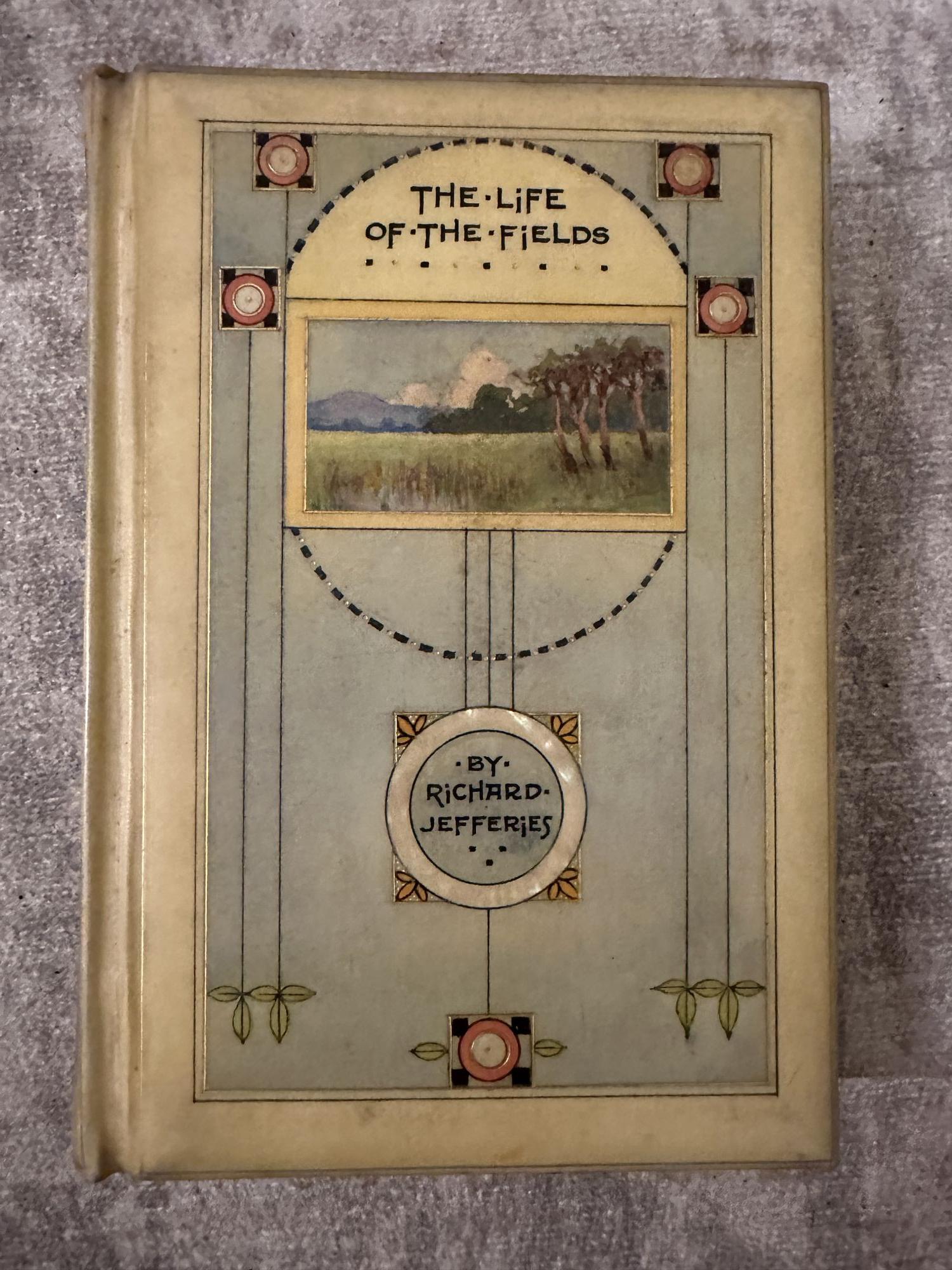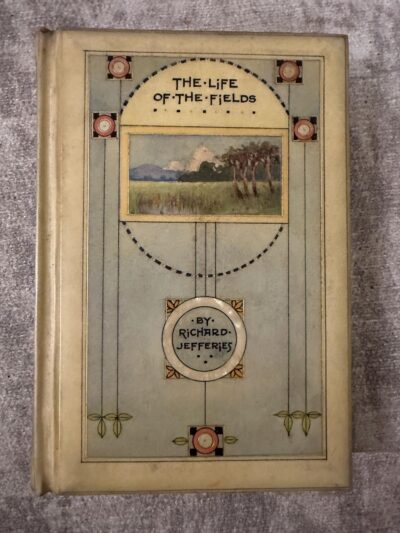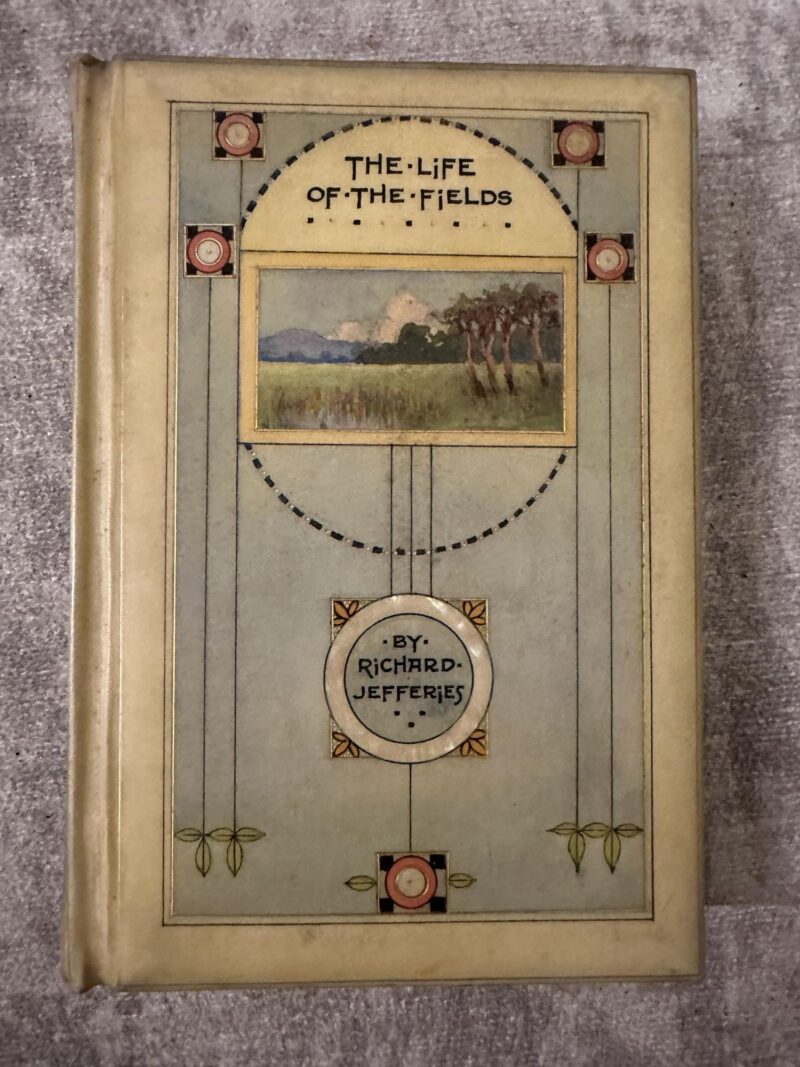
Cedric Chivers “vellucent” binding
- $2,750
Jeffries. R. The Life of the Fields. London, 1908. 8vo. In a Cedric Chivers "vellucent" binding. Some foxing internally. Cedric Chivers (1853-1929) was an innovative English bookbinder and publisher known for his significant contributions to the preservation and restoration of old books. Chivers is particularly renowned for his development of the "vellucent" binding process, where the artwork on a book cover is painted on the underside of transparent vellum, protecting the delicate painting from wear while enhancing the book's aesthetic appeal. Operating out of Bath, England, his work extended beyond craftsmanship to a commitment to library preservation, introducing methods like the "Chivers' Patent" binding which allowed books to lie flat when open, reducing stress on their spines and contributing to their longevity. His dedication to bookbinding and preservation left an enduring legacy in the world of bibliophily and library sciences.
More from Adam Weinberger Rare Books
Rare 1870 Mormon Map
Froiseth, B.A.M.; artist. Great Salt Lake Valley / Map of the Territory of Utah / Plat of Salt Lake City. (UTAH.) Froiseth, B.A.M.; artist. Great Salt Lake Valley / Map of the Territory of Utah / Plat of Salt Lake City. With inset portrait of Brigham Young. Hand-colored lithograph, 16 1/2 x 13 3/4 inches; folds, minimal wear along upper left edge. (MRS) New York: American Photo-Lithographic Co., 1870.THE SIEGE OF BREDA
HUGO (HERMAN, SJ) THE SIEGE OF BREDA written in Latin. translated into English by C[aptain] H[enry] G [age], FIRST EDITION IN ENGLISH [Gent, J. Dooms], 1627. Small Folio 32 cm., 3 preliminary leaves, 152 pages. (lacking portrait) 15 plates (6 double; including map, plans) . VERY RARE IN COMMERCE. [STC 13926]. Contemporary calf, some wear to spine, small loss at top and hinges starting Particularly interesting as a rare English work priunted in Ghent and also notable for the unusual Chronogram in the colophon Sir Henry Gage (1597-1645), the translator, received his education in Flanders and subsequently served in the Spanish garrison at Antwerp. He made a name for himself during the 1622 siege of Bergen op Zoom and the 1624 siege of Breda. However, following the fall of Breda and the reduction of English regiments in Spanish service, coupled with the onset of war between England and Spain, Gage was compelled to return to England. He subsequently dedicated his time to studying the theory of war, with this translation being among his most notable scholarly contribution Ghent, being part of the Spanish Netherlands during this period, was under the influence of the Catholic Habsburgs. The Jesuits, like Herman Hugo, were a Catholic order, and their works might have found more support and less censorship in such environments compared to Protestant areas. This Catholic connection might have made Ghent a more sympathetic location for publishing a work by a Jesuit author.Aldus the Younger
[ALDINE] ALDUS MANUTIUS THE YOUNGER. DE QUAESITIS PER. EPISTOLAM LIBRI III. VENICE, 1576. 3 parts in one, 8vo. 18th century calf, spine label missing, with some spoiling and wear and maybe old glue repair to hinge; internally positions affected by light damp stain. Woodcut portrait vignette of Aldus the Elder on title, decorative woodcut initials Scarce work by Aldus Manutius the Younger, who was the son of Paulus Manutius, a renowned scholar of Cicero, and the namesake grandson of the illustrious Venetian printer Aldus Manutius, explores various subjects including astronomy, the Ptolemaic dynasty, and aspects of the liberal arts. Aldus the Younger represents the final generation of the Manutius family to operate their celebrated printing press in Venice.1860 One of the Earliest Photographically Illustrated Books
1860 One of the Earliest Photographically Illustrated Books Marble Faun 2 vols in 1. Small 8vo with approx 60 mounted albumen photographs; xii, 292; xi, 280 & [1] pages; Two volumes bound in one. Contemporary full vellum, in UNUSUALLY fine clean condition with the most minor blemishes, title stamped in gilt: "THE MARBLE FAUN" (using the American title of Hawthorne's novel, rather than the British title "Transformation" which had also been adopted for this Tauchnitz edition. The book became popular enough to support a small industry focused on its sale, often with copies luxuriously bound and augmented with original albumen print photographs. According to Professor William B. Todd, co-author of the comprehensive history of Tauchnitz International Editions in English, "The Marble Faun" is frequently found with extensive photographic illustrations, serving as an ornate guide to Rome. This particular copy includes 60 photographs, each affixed to its own sheet and integrated within the book. These include a portrait of Hawthorne himself as the frontispiece, with many images depicting iconic statues, paintings, and vibrant street scenes in Rome, featuring local inhabitants.Johannes Oporinus’s copy (?) of a 1526 Macrobius
[Early Printing]. Macrobius. IN SOMNIUM SCIPIONIS LIBRI DUO et Septem Eiusdem Satumaliorum. Nunc denuo recogniti & multis in locis aucti. Coloniae: Apud Eucharium Ceruicomum, 1526. Folio. (6),140 leaves. Handome copy in 18th/early 19th century vellum, which reused a medieval manuscript. Internally, some toning and some small worming to text., edges died blue , blanks old but replaced. From the esteemed library of Georgius Klok with bookplate. PROVENANCE : signature of Oporinus in a 16th century hand to lower title page. With woodcut diagrams and WORLD MAP in the text. Marcrobius is now little known apart from the present collection of works, which includes his famous cosmographical commentary on Cicero's Somnium Scipionis (Scipio's Dream). First published in 1472, the works enjoyed wide popularity well into the sixteenth century. The handsome title page illustration can be attributed to Hans Holbein, who crafted a title page with a three-dimensional, ornamental style that included an image of Cleopatra engaging in suicide by snake, possibly an Egyptian asp. The title "Acrobius. IN SOMNIUM SCIPIONIS LIBRI DUO et Septem Eiusdem Satumaliorum" refers to works by the ancient Roman scholar Macrobius, focusing on two major texts. "In Somnium Scipionis," or "The Dream of Scipio," is a fascinating philosophical exploration based on Cicero's work, delving into themes of cosmic and individual destiny, and the nature of the soul. It was widely read and revered in the Middle Ages and Renaissance for its rich insights into Neoplatonism. The second part, "Saturnalia," consists of seven books that discuss a wide range of topics, presented in the form of dialogues held during the Saturnalia festival, an ancient Roman feast. This work serves as a comprehensive compilation of Roman social and cultural customs, philosophical thoughts, and literary criticism, providing a snapshot of intellectual life in late antiquity. Very possibly the copy of Johannes Oporinus, who holds a significant place in the history of printing and intellectual discourse due to his daring role in the dissemination of radical and groundbreaking texts during the Renaissance. As a printer in Basel, Oporinus not only facilitated the spread of scientific knowledge through the publication of Andreas Vesalius' seminal work on human anatomy, "De humani corporis fabrica," but also engaged in the religious and philosophical debates of his time by printing texts from reformers like John Calvin. His courageous decision to print the first Latin translation of the Quran introduced European scholars to Islamic religious texts, broadening the scope of religious and cultural understanding. Oporinus' work exemplifies the pivotal role of printers in the Renaissance as agents of change, challenging established norms and expanding the boundaries of knowledge. His contributions helped pave the way for modern scientific inquiry and religious tolerance, making his imprint on history both indelible and profound.1570. Chronicle of the Eastern Roman Empire – Byzantine
Chronicle of the Eastern Roman Empire, starting with Emperor Nikephoros up to the year 1453, composed by the Byzantine court historian Johannes Scylitzes (died after 1081). Scylitza, Johannes. Historiarum compendium, quod incipiens à Nicephori Imperatoris, à Genecis obitu, ad Imperium Isaaci Comneni pertinet.Venice, Dominicus Nicolonius, 1570. Folio, Vellum 30-5 x 20 cm. Early titling to side. 10 leaves, 151 pages, 1 leaf. With woodcut printer's mark on the title page. Some early marginal annotations, some browning but generally handsome Dimensions 30.5 x 21 cm. . EDIT 16 CNCE 31692. STC 619. PROVENANCE: Robert Pierpont Blake (1886-1950), American Byzantinist and scholar of the Armenian and Georgian cultures.1509 Post Incunable Vocabulary – Very Rare
Vocabulista ecclesiastico latino e vulgare utile e necessario a molti, gothic letter, double columns, woodcut initials, with the final blank, Venice, Simon de Luere, 26 May 1509. small 8vo.,m 10 x 14 cm., 61, [1] 19th century vellum over boards. VERY RARE. And a charmingly printed book. OCLC cites copies on only in the Bnf and Biblioteca Nazionale Centrale di Roma "Vocabulista ecclesiastico latino e vulgare utile e necessario a molti" is an Italian title that roughly translates to "Ecclesiastical Latin and Vulgar Vocabulary Useful and Necessary for Many." This book is likely a resource for individuals interested in learning ecclesiastical (Church) Latin and its vernacular equivalents. It might contain vocabulary lists, grammar explanations, and perhaps sample sentences or passages to aid learners in understanding and using Latin in ecclesiastical contexts. Ecclesiastical Latin is the form of Latin that developed and has been used by the Catholic Church for liturgical and scholarly purposes. It differs somewhat from Classical Latin in vocabulary, pronunciation, and usage, reflecting its evolution over time within the context of the Church. Such a book would be valuable for individuals studying theology, history, or classical languages, as well as for clergy members or scholars engaged in research related to the Catholic Church or its historical documents.1653 Woman English Printer Gertrude Dawso
[WOMAN PRINTER] [ANTI-SEMITISM] Eleazar Bar-Isaiah, pseud. "A Jew born." A Vindication Of The Christians Messiah, (Viz.) That Jesus Christ the Sonne of God is the true Messiah prophesied of, or foretold by all the holy men of God who were the Writers of the old Testament, from Genesis unto the Prophet Mallachy. As also proved out of their own beloved Talmouth. Wherein is also declared, the Coherence which the Old Testament hath with the New, as to that particular. As also a clear proof of the Trinity in Unity, (Viz.) That the Father, Sonne, and Spirit, are but one God. Against the generall received opinion of the Jewes. London, Gertrude Dawson, 1653. 4to., 18 x 13 cm., T.p. toned and frayed, last leaf with some toning and fraying. Complete. (10), 66 p. dedicated: To the Supreám Authority, the Parliament etc. Binding: Modern boards and half morocco. VERY RARE IN COMMERCE. No copies in the auction records since 1984. Eleazar Bar-Isaiah evidently served in the Royalist army prior to this treatise against the Jews that fits in the with the greater trends towards Sabbatean and Messianic beliefs, spurred by the tumultuous times of the Interregnum. It is recorded however that his conversion may have also been disingenuous and prompted largely by the love of a woman who refused otherwise to marry him. This is also a very interesting imprint by one of the more notable women printers of 17th century England, Mrs. Gertrude Dawson, who had an establishment opposite Half Moon tavern, Aldersgate Street, London. Dawson inherited the printing house in 1648 and demonstrated an interest in fine printing despite the increasingly commercial and cheap productions of the period. She inherited ornaments, such as a variation on an Aldine device form her husband, but also had herself cut a new font of roman type after taking over the business - something unusual and enterprising as she could have clearly relied upon the still functioning inherited typefaces. In that regard, it might be noted the rather charming detail that the headers in the tract are are unusual example that incorporates a little "bat"WILKINS, John (1614-72). Mathematical Magick
WILKINS, John (1614-72). Mathematical Magick: or, The Wonders that may be performed by Mechanical Geometry. In Two Books. Concerning Mechanical Powers [and] Motions. Being one of the most easie, pleasant, useful (and yet most neglected) part of Mathematics, Not before treated of in this Language. London: Printed for Edw. Gellibrand, 1680. 8vo .(170 x 105mm). Engraved portrait frontispiece of the author, dedication "To His Highness the Prince Elector Palatine," engraved illustrations, woodcut diagrams generally lightly browned. Contemporary calf, some small loss to spine, hinges weak and starting to separate but holding. Ref: Maggs. Bibliotheca mechanica, p.354; Honeyman VII, 3120; Wing W2200 (most references citing the first edition of 1648). John Wilkins' "Mathematical Magick," first published in 1648 and later reissued here in a second edition, stands as a remarkable piece of early scientific literature that delves into the fascinating world of mechanical inventions and theoretical engineering. This work has 72 pages specifically dedicated to the exploration of perpetual motion machines-a concept that has intrigued and challenged scientists and inventors for centuries-and offers a rare glimpse into the inventive mind of the 17th century. Wilkins, an ambitious thinker and inventor, not only presents a collection of existing designs for machines intended to achieve perpetual motion but also contributes his own innovative ideas to the field. Furthermore, "Mathematical Magick" encompasses a broad spectrum of other groundbreaking topics. Chapter XIII, for instance, focuses on the utilization of magnets in various mechanical applications, showcasing Wilkins' interest in magnetism and its potential uses. The book also ventures into the realms of aerostation and aviation, presenting early theories and designs for flying machines or "volant automata," which Wilkins discusses in terms of the art of flying, analyzing various methods and addressing the significant challenges that hinder the realization of a practical flying chariot. Additionally, Wilkins explores other advanced technological concepts for his time, such as the creation of motion through rarified air, the mechanics behind wind-guns, and the principles of submarine navigation, including the innovative use of the compass for steering underwater vessels. Through these discussions, Wilkins' work provides a comprehensive overview of the state of mechanical and engineering knowledge in the mid-17th century, offering insights into the imaginative and often audacious attempts to extend the boundaries of contemporary technology and understand the natural world.Illustrated Sketches of Death Valley
An Evocative Exploration of Death Valley: Pictorial and Descriptive Insight into the Borax Deserts of the West Coast Spears offers readers a vividly descriptive journey through Death Valley Spears, John R. Illustrated Sketches of Death Valley and Other Borax Deserts of the Pacific Coast : 226 pp. Features photographs and a map detailing the Borax zones along the Pacific Coast. Dimensions: 19x12.7 cm (7½x5"). Chicago, 1892. Variant issue, with yellow cover pasted over later boards and library spine. Internally with old reinforcement to inner hinge. A VERY RARE Book. Spears presents a detailed depiction of Death Valley as it was in the year 1891, providing a narrative that predates Manly's account by a couple of years. "Illustrated Sketches" is distinguished as much by its pioneering photographs as by the narrative it conveys. These images might be among the earliest-if not the very first-published photographs of the Death Valley area, lending them significant historical value. Edwards highlights their utmost significance, while Paher recognizes the book as not only one of the paramount Death Valley chronicles but also a key piece of Nevada literature. Spears stands out as the inaugural professional writer-photographer to document the happenings in the desert expanses. - Referenced in Paher 1844; Cowan p. 604; Edwards, "Enduring Desert" p. 227; Graff 3926; Howes S821; listed in Zamorano Select 103.RARE EDITION OF MARTIAL WITH THE OBSCENITIES REMOVED
RARE EDITION OF MARTIAL WITH THE OBSCENITIES REMOVED BY THE GREAT CONRAD GESNER Martial, Conrad Gessner. M.V. Martialis . Epigrammata, ad linguae latinae copiam & varias rerum nomenclaturas utilissima, recens ab omni verborum obscoenitate in adolescentium praecipuè scholarumq[ue] usum expurgata, & in locos circiter LXXX digesta, ac plaerisq[ue] in locis excudebat Froschouerus, Tiguri, 1544. Blindstamped pigskin with remnants of clasps. Rare edition. BOUND WITH Jun. Juvenalis Satyrae : luculentissimae, iam iterum curiosius a mendis adsertae, adnotatiunculis margini adfixis, una cum huiusce dictionis amplissima elucidatione .ohann Gymnich, Coloniae, 1541 If you are like most Gen Z, these days, and find Cicero and Virgil a bit too stuffy, when Martial's 1st-century Latin epigrams are filled with hilarious vulgarity and sexual innuendo. But if you want to delve into Roman potty humor, I wouldn't suggest buying this 1544 edition from me, even if it is a handsome copy in blind-stamped pigskin. The title page states that this edition has been 'Recently purged of all obscenity for the special use of young students and schools.'"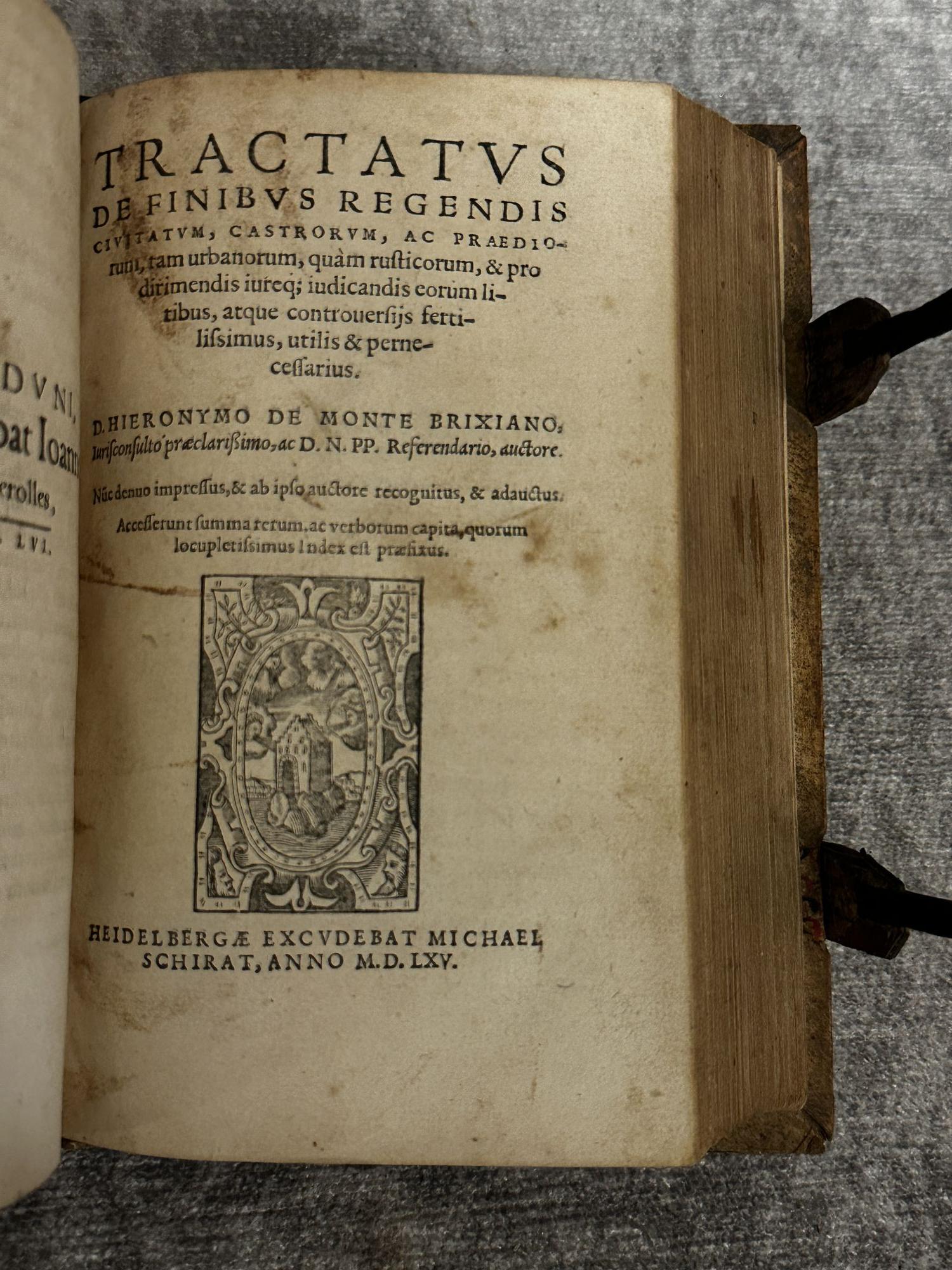
TWO VERY RARE LEGAL WORKS BOUND
TWO VERY RARE LEGAL WORKS BOUND IN 1 INCLUDING AN IMPORTANT ONE ON LAND BORDERS AYTTA, Viglius Zuichemius ab Commentaria in decem titulos Institutionum iuris civilis. Accesserunt & his Oliverii Textoris Commentaria in tit. De gradibus cognationum earundem Institutionum. Lyon J. Faure for the Heirs of J. Giunta 1562 8vo: 1 7 x 10 cm. RARE. Blindstamped vellum (one small hole to vellum) and clasps. Authored by the distinguished jurist Vigilius Zuichemus Phrysius, this work presents a deep exploration of ten titles of Justinian's Institutes, offering rich commentary that reflects the legal thought and interpretation of Roman law in the Renaissance BOUND WITH Hieronymus de Monte. Tractatus de finibus regendis civitatum, castrorum, ac praediorum, tam urbanorum, quam rusticorum, & pro dirimendis iureque iudicandis eorum litibus, atque controversiis fertilissimus, utilis & pernecessarius. Nunc denuo impressus & ab ipso auctore recognitus & adauctus. Heidelberg: Schirat, 1565. VERY RARE. "Tractatus de finibus regendis civitatum, castrorum, ac praediorum, tam urbanorum, quam rusticorum, & pro dirimendis iureq[ue] iudicandis eorum litibus, atque controversiis fertilissimus, utilis & pernecessarius," roughly translates to "Treatise on the Management of the Boundaries of Cities, Camps, and Estates, both Urban and Rural, and for Settling and Judging by Law Their Disputes and Controversies, Most Fruitful, Useful, and Necessary." This work by Hieronymus de Monte, printed in 1565, is a legal treatise focusing on the management and delineation of boundaries for cities, military camps, and both urban and rural properties. It discusses the legal frameworks for resolving disputes and controversies related to these boundaries. Such treatises were essential during a time when local governance, the demarcation of territories, and the rights to land were of paramount importance, both for practical management and legal jurisdiction.PRINTED 1688: HELPED SHAPED MODERN LAW
PRINTED 1688: HELPED SHAPED MODERN LAW Gothofredus, Dionysius. Corpus Juris Civilis. Additional engraved title-page (detached), engraved frontispiece. 4 parts in 1 volume. Thick 4to. 26 x 21 cm. Frankfurt am Main, 1688 Contemporary vellum, with handsome embossing and date. A typographical marvel considering how many line sof times, and some quite miniscule Dionysius Gothofredus (also known as Denis Godefroy or Godofredus) was a 16th-century legal scholar renowned for his edition of the "Corpus Juris Civilis," a collection of fundamental works in jurisprudence, issued from 529 to 534 by order of Justinian I, Eastern Roman Emperor. Gothofredus was born on September 17, 1549, in Paris, and his work on the "Corpus Juris Civilis" is among his most significant contributions to the study of Roman law.1869 A SMUGGLED LIBRARY – AUCTION C ATALOG
ANDRADE, Jose Maria -- Catalogue de la Riche Bibliotheque de D. Jose Maria Andrade. Livres manuscrits et imprimes. Litterature francaise et espagnole. Histoire de l'Afrique, de l'Asie et de l'Amerique. 7000 pieces et volumes ayant rapport au Mexique ou imprimes dans ce pays. Leipzig: List & Francke; Paris: Librairie Tross, 18 January 1869. 8o (218 x 140 mm). Original yellow wraps, minor wear. RARE This esteemed collection, notable for its extensive range of early Americana and Mexican publications, was amassed over a period exceeding 40 years by the journalist and publisher Andrade in Mexico. Initially intended to establish the core of the Imperial Library of Mexico, this ambitious project was disrupted by the onset of the Mexican Revolution. Consequently, the collection was clandestinely transported out of Mexico and ultimately auctioned off in 1869.- $750
- $750
1750 Barbary Pirates – First Edition in English
[PIRATES] Africa.- [Laugier de Tassy (Jacques Philippe)] A Complete History of the Piratical States of Barbary, [translated by Joseph Morgan], London, 1750. 8vo., 20 s 12 cm., 2 folding engraved maps, omne with year without loss, contemporary calf, gilt, front board detached. , internally some edge staining but generally good, small loss to first blank. FIRST EDITION IN ENGLISH. Laugier de Tassy's "Histoire du Royaume d'Alger," first published in 1725, offers an insightful glimpse into the world of Barbary piracy, focusing on the Kingdom of Algiers. This comprehensive work details the corsairs' operations, outlining their strategies, naval strengths, and the economic and political impact of their piracy on Mediterranean trade. Tassy meticulously describes the lives of European captives, the intricate ransom negotiations, and the socio-political dynamics that allowed piracy to thrive along the Barbary Coast. His account, significant for its detailed portrayal of 18th-century North African piracy, sheds light on the complex interaction between the Barbary States and European powers, painting a vivid picture of a tumultuous era defined by maritime predation and cross-cultural encounters.- $750
- $750
VIRGINIA. Message of the Governor, Dec. 7, 1863. Richmond, 1863
CONFEDERATE VIRGINIA. Message of the Governor, Dec. 7, 1863. Richmond, 1863. DOC. No. 1 8° stitched in original wraps. EXTREMELY RARE CONFEDERATE IMPRINT in commerce, with a powerful speech on the righteousness of the Southern Cause. Wraps with minor chipping and toning. In 1863, during the thick of the American Civil War, Virginia stood as a primary battleground and key stronghold of the Confederate States. By December of that year, the state had already witnessed a series of critical confrontations, most notably the Battle of Chancellorsville in early May. Here, Confederate General Robert E. Lee achieved one of his most remarkable victories, overcoming a numerically superior Union force. Amidst this tumultuous backdrop, the "Message of the Governor, Dec. 7, 1863" would have been delivered, reflecting the state's perspective and condition in a war that was tearing the nation apart. Given the significant events of that year in Virginia, the Governor's message would likely address the state's wartime challenges, military updates, and possibly calls for unity and resilience against the Union forces.- $400
- $400
c. 1816 Manuscript of General James Wilkinson – Secret American Agent #13
SECRET AGENT AND ONE OF THE MOST ENIGMATIC CHARACTERS IN AMERICAN HISTORY ORIGINAL MANUSCRIPT WILKINSON (GEN, JAMES). Manuscript leaf. s.d. circa 1816. 1 page as depicted. possibly from his "Memoirs," accusing President Monroe of misuse of public funds. : "I recollect that mystery and reserve was the outcry against Gen. Washington's administration, but to mystery and reserve, those who hated him and traduced him, Monroe particularly, have added the masks of falsehood and 'hypocrisy to conceal or to justify their follies." Sold at auction Anderson Gallery in 1912 Lot 289 from the Library of Benson Lossing, Benson John Lossing (February 12, 1813 - June 3, 1891) was a prolific and popular American historian, known best for his illustrated books on the American Revolution and American Civil Warand features in Harper's Magazine. He was a charter trustee of Vassar College. As the Governor of the Louisiana Territory, Wilkinson, known as "Agent 13," almost jeopardized the Lewis and Clark expedition because he saw it as a threat to his personal and perhaps Spanish interests. Later, during the Monroe administration, his reputation was further tainted when his past machinations with Spain were brought to light, but he was cleared in a court-martial due to lack of solid evidence. Throughout his career, Wilkinson's loyalty to the United States was frequently in question, making him one of the most enigmatic figures in early American history.- $1,500
- $1,500
History of the Fifty-FourthRegiment
[AFRICAN AMERICANA - 54TH MASSACHUSETTS]. EMILIO, Luis F. (1844-1918). History of the Fifty-FourthRegiment or Massachusetts Volunteer Infantry, 1863-1865. Boston: The Boston Book Company, 1894. 8vo. 20 plates, 7 maps and plans, 2 folding maps Publisher's black cloth gilt, wear to edges and rubbing to spine with wear to head and foot of spine, a few minor soiling marks internally. EXTREMELY RARE SECOND EDITION of the book "A Brave Black Regiment" but actually more important and RARER than the 1891 First diue to the new chapter (Appendix) included not in the 1891 edition on the treatment of African American Prisoners of War . Last copy art auction in 2023 of the 1891 sold for $4000 The Book details the storied journey of the 54th Massachusetts Infantry, the North's inaugural African American regiment during the Civil War. Renowned for their valiant effort in attacking Battery Wagner, the unit counted among its ranks two sons of abolitionist Frederick Douglass and William Carney, the first Black recipient of the Medal of Honor. The book also features a comprehensive list of members and more than 80 photographic portraits of its officers and soldiers. Luis Emilio was initially a member of the 23rd Massachusetts' Company F, enlisting at the war's outset and even falsifying his age to do so. He participated in the Roanoke Island battle and climbed the ranks to become a sergeant. After the Emancipation Proclamation led to the formation of the 54th Massachusetts, Emilio's prior military experience and his family's anti-slavery views helped him secure a position as a 2nd lieutenant.- $1,000
- $1,000
Rare Bodoni imprint
Cerati Antonio Elogio di Sua Altezza Reale Donna Isabella Infanta di Spagna Arciduchessa d'Austria ec. ec. ec. 8vo. 21 x 13 cm., [16], 85, [2] Parma. Printed By Giambattista Bodoni , 1780. 18th century mottled calf, some wear to corners, marbled endpapers., internally some occasional edge toning, occasional minor stains. RARE. A handsome and rare book from the Press of the incomparable Giambattista Bodoni , Bodoni crafted typefaces that exuded sophistication and clarit in an age when the commercialization of printing often resulted in inelegant productions The book is a tribute to Isabella of Austria , daughter of the Spanish Count of Parma Elizabeth of France. In 1760 she became the wife of Joseph II and succumbed to melancholy that led to her death: "- $650
- $650
1820 Miniature Hand Colored Atlas 56 Maps
Darton, William. Darton's New Miniature Atlas containing a complete set of County Maps. London, circa 1820. 8vo . 155 x 90 mm. engraved title, index and 56 engraved maps (including plan of London), contemporary hand color. Binding: half calf and marbled boards, worn, some small peeling and losses to spine. Internally, minor toning, but very good. A charming atlas, scarce in commerceas it is sadly often broken for its charming well executed small maps.- $1,200
- $1,200

1837 Book on Pirates
THOMAS (R.) An Authentic Account of the most Remarkable Events: Containing the lives of the most noted Pirates and Piracies. New York, 1837, Collation pp. (2), 5--298, 12 plates; (2), 5--359, (1), 13 plates. Binding: plain red cloth; internally some general foxing throughout. A Rare American book on Pirates.- $700
- $700
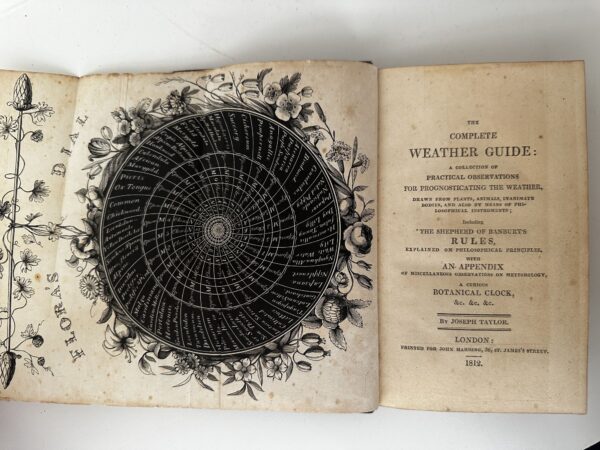
1812 Book on Weather Prediction
[WEATHER PREDICTION]). TAYLOR, JOSEPH. The Complete Weather Guide: a Collection of Practical Observations for Prognosticating the Weather, Drawn from Plants, Animals, Inanimate Bodies, and Also by Means of Philosophical Instruments. London: for John Harding, 1812. First Edition. Small 8vo, 16 x 9.5 cm. Early calf and marbled boards, somewhatrubbed. The beautiful and unusual engraved folded frontispiece of "Flora's Dial". is present explaining when various flowers close or open. RARE. The book contains a compilation of folklore, scientific observations derived from plant studies, and basic knowledge of barometric instruments. Although it was reprinted multiple times in later years, the initial edition was quite rare.- $450
- $450
Cedric Chivers “vellucent” binding: https://rarebookinsider.com/rare-books/cedric-chivers-vellucent-binding/
